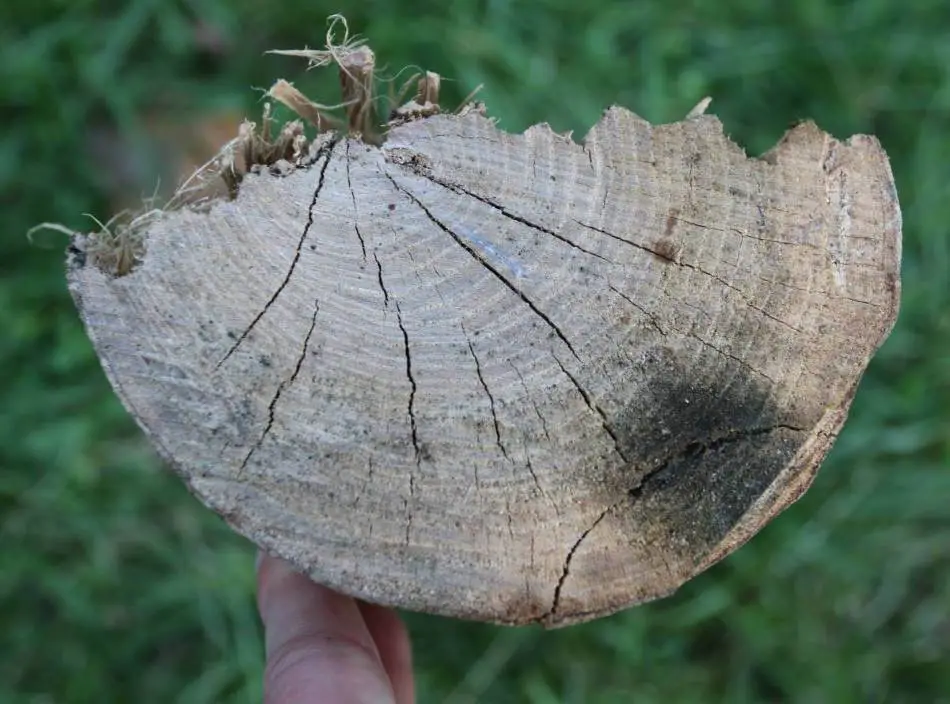
Wondering if you should try burning Elm? There’s a lot of different types of firewood out there. Some of it is not even worth burning, and other types make excellent firewood. So, what about Elm?
Is Elm good firewood?
Elm is relatively poor firewood. It has a low heat output of 20 million BTUs per cord of seasoned wood, which is much lower than dense hardwoods like Hickory and Oak. Elm is also very difficult to split, and it produces a moderate level of smoke.
But there’s more to it than this short summary, and if you have a lot of Elm you can definitely still burn it.
Below, we’ve compiled data from several university extension offices to give you a detailed view of the most important characteristics of Elm firewood, and how it stacks-up (pun fully intended). Let’s get to it!
Elm vs. Other Firewood

To help you a quick look at how Elm compares to other types of firewood, we’ve put together a graphic below, which provides a snapshot of some of the most common types of firewood in our area (in the Midwest USA), and they are divided into 3 levels of quality.
Within each tier, the types of firewood are not ranked but are considered close in performance. Also, the tiers are actually based primarily on data from several university extension offices.
To learn more about the data sources, you can read the note below the image. Now, here it is!
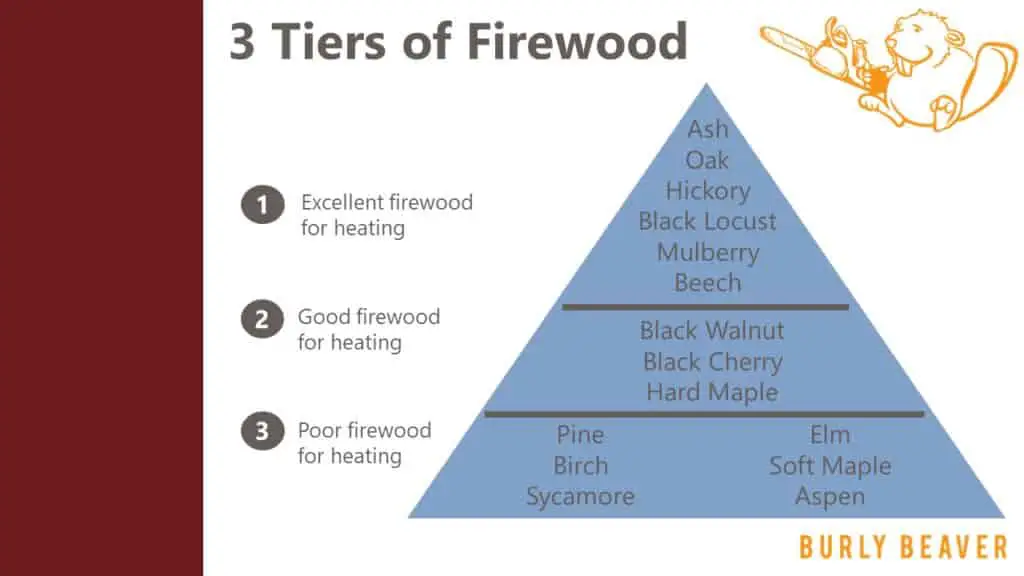
The information in this image is based largely off of data from the following sources: Utah State University Forestry Extension, Oklahoma Cooperative Extension Service, University of Illinois Extension, University of Missouri Extension, South Dakota State University Extension. In addition, where there was missing data (only a few occasions), I’ve used my own experience to round out the data.
In addition to heat output, these levels of quality take additional factors into consideration, including smoke output, quality of coals, and fragrance. See the section below to see how Elm performs for each burn characteristic.
The 6 Burn Qualities of Elm
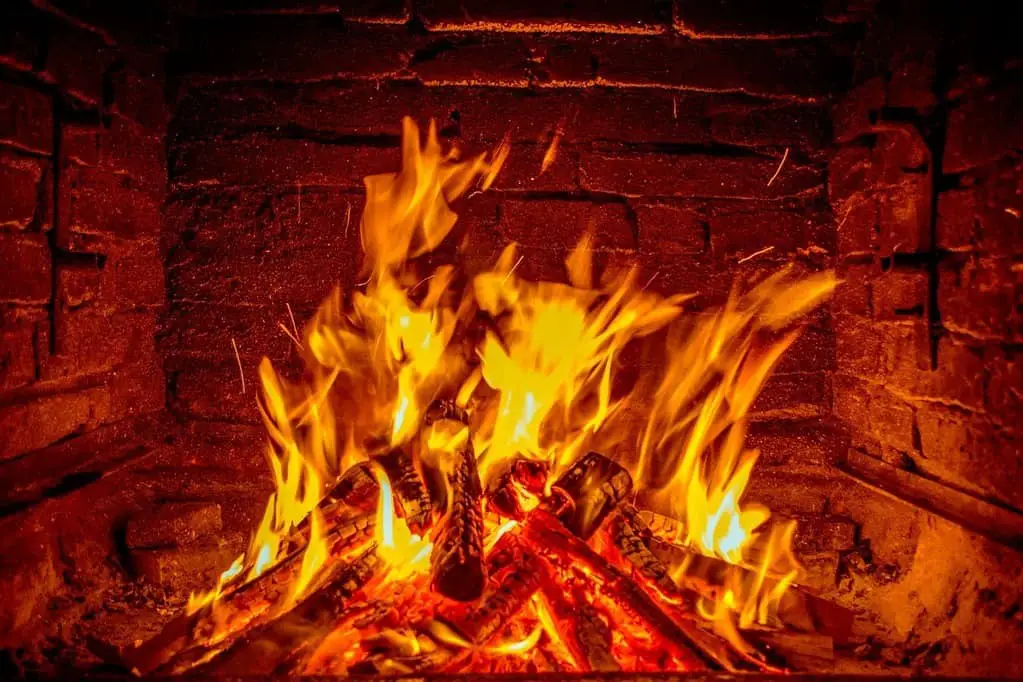
1. Heat Output vs Other Firewood
Elm is not a good performer on heat output. You can see this really clearly by looking at the numbers.
Check out the table below to see a more data-driven comparison of the heat output for 15 common firewood species’.
Elm is marked with bold text below. (Note: data sources are mentioned beneath the infographic above).
Heat Output of Common Firewood
| Species | BTUs | Weight/Cord (lbs) |
| Black Locust | 29.3 | 4192 |
| Hickory | 28.5 | 4072 |
| Beech | 27.5 | 3760 |
| Oak (White) | 26.4 | 3776 |
| Mulberry | 25.8 | 3712 |
| Ash | 24.2 | 3472 |
| Maple (Hard) | 23.9 | 3408 |
| Black Walnut | 22.2 | 3192 |
| Pine (Southern Yellow) | 22 | 2936 |
| Birch | 20.8 | 2992 |
| Sycamore | 24.1 | 2872 |
| Black Cherry | 20.4 | 2928 |
| Elm | 20 | 2872 |
| Maple (Soft) | 19 | 2752 |
| Aspen | 18.2 | 2160 |
Heat output is definitely an important characteristic for firewood, but it’s not the only thing that matters. There are a few other factors, that will affect how good the wood is for heating or for outdoor campfires.
Next up, let’s look at smoke output.
2. Amount of Smoke
Elm is in the middle of the spectrum here. It doesn’t produce a lot of smoke, but it produces more smoke than many of the top tier firewoods like Ash and Oak.
High smoke production may also be a sign that wood is not fully dried, and you want to make sure that you’re always properly seasoning your wood before burning it. Jump down to this section to learn more about seasoning.
3. Does it Spark?
Some types of firewood pop or spark really badly, which may not seem like an issue at first, but it can actually be a big problem.
Wood that sparks heavily can create significant fire hazards, which can cause problems in both open-air (e.g. outdoor) and enclosed fireplaces. Mulberry is an example of a wood that sparks heavily.
Elm produces minimal sparks, so it’s actually a really good performer in this category and is not as likely to cause fire hazards. However, it’s still a good idea to monitor any type of open-air fire.
4. Smell or Fragrance
Some types of firewood are famous for having a nice fragrance. Cherry and Hickory are both great examples of this. Since smell is so closely associated with flavor, some fragrant woods are also used for BBQ and smoking meats.
But Elm firewood is definitely not in that club.
The problem with Elm is that it absorbs the smell of whatever it’s growing around. So if you cut down an Elm tree that was growing near a smelly swamp (or worse, a sewer), then you can expect it to smell VERY bad.
Keep an eye on where the Elm is coming from, and don’t burn it until it’s fully dried. If you do both of those things, then the smell will be much milder and could even be pleasant. The conditions are a huge factor here.
5. Does it Produce Coals?
Another factor that is commonly used for rating firewood is “coaling”. When any kind of firewood burns it produces coals, and the quality of the coals produced has a big impact on how long (and how well) the fire will continue burning.
Firewood that is on the top of the list for BTU output, tend to have very good coaling properties, but Elm actually performs really well on coaling also.
Even though Elm is not as dense as Hickory and Black Locust, it still produces very good coals which will significantly outperform woods like Pine, Birch, or Aspen.
6. Creosote Build-Up
If you’re using a fireplace or wood stove in your home, another important thing to consider is the maintenance of your chimney, and specifically preventing creosote build-up.
If you’ve not heard of creosote before, it’s a side product of burning wood, and it’s basically a black tar that is gradually deposited by wood smoke on the inside walls of a chimney.
Creosote isn’t a problem in small quantities, but if it gets built up, it can be quite dangerous. Build-up of creosote can reduce the ventilation of your chimney, and it’s also HIGHLY flammable, which can cause chimney fires.
To prevent creosote build-up, it’s important to properly maintain your stove and to have your chimney cleaned regularly.
In addition, you should only ever burn wood that is thoroughly seasoned (dried), because wet wood produces more creosote. Another big factor is the type of wood you’re burning.
In general, firewood that is very sappy will produce much more creosote build-up than firewood that is not as sappy.
Most hardwood firewood, including Elm, have low sap levels and produce less creosote than very sappy firewood like Pine.
Speaking of Pine, it’s probably the worst type of wood when it comes to creosote build-up. Many people, including my family, completely avoid burning Pine in wood stoves as a result.
Burn Quality Overall Comparison

Alright, now that we’ve covered the 6 most important burning qualities for Elm, let’s boil it down to the biggest highlights.
- Elm has low heat output compared to other common firewoods, so it’s not the top choice if heating is your goal.
- Elm can have a very bad smell if it’s green or if it grew near something else that smells bad, like a stinky swamp or a sewer line.
- Elm produces excellent coals and even outperforms heavier types of wood in this category, including Ash and Walnut.
- Elm is difficult to split because the wood is very stringy and binds itself together tightly, it is even harder to split than Hickory and Ash.
Next, let’s touch briefly on an easy way to identify Elm firewood.
Easy Trick to Identify Elm Firewood

Elm has a unique characteristic on the end grain of it’s wood, that you can use to easily separate it from all other types of firewood.
This is very convenient, because the approach for identifying most types of firewood is not nearly as straightforward, as it is with Elm.
So here’s what you need to look for: Elm has wavy annual rings.
The annual rings on a piece of wood, are the circles that go from the inside to the outside of the wood. It’s also the rings you can count to tell the age of a tree.
You can see the slight waviness of the rings in the photo above. If you start at the center of the log, you can see it more clearly. Other types of wood still have the annual rings, but they all have normal (e.g. not wavy) circles.
To summarize, if you find a piece of wood and the rings on the end are wavy, then you definitely have a piece of Elm.
If for some reason this doesn’t work for you, maybe if you’re trying to identify a live tree, then you can always use the leaves as well.
Below is an image of a few Elm leaves. Elm leaves are alternate-simple, meaning they grow in a “left-right-left” pattern along branches, and each leaf is single (e.g. not part of a compound leaf).
As you can see in the photo, the edges of the leaves also look serrated. Plus, the bottom of the leaves may feel fuzzy, almost like a peach.
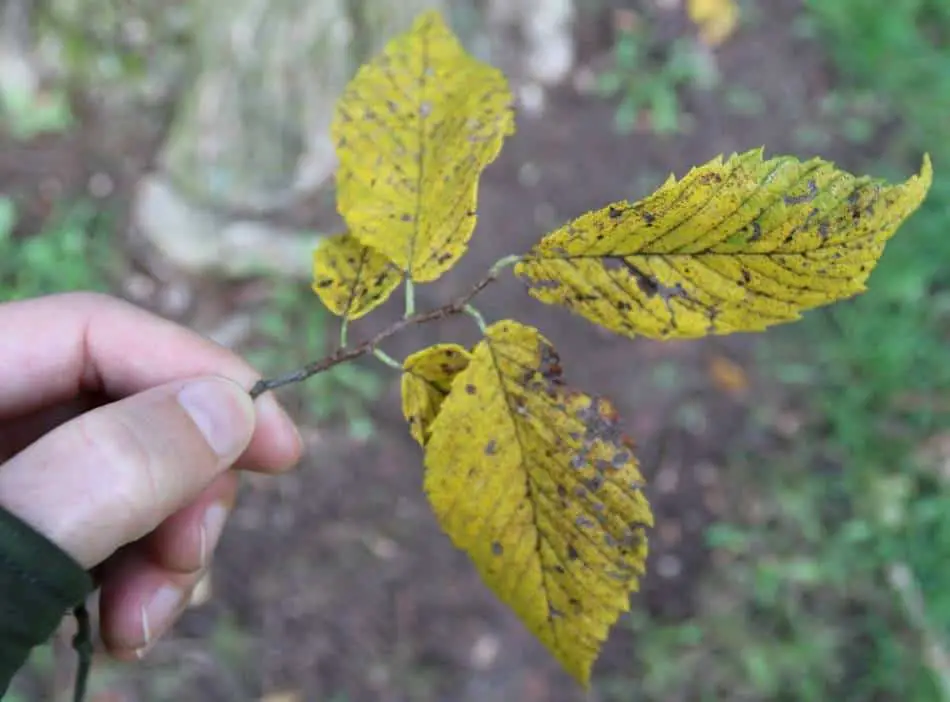
Now for our final topic, seasoning your elm firewood.
Seasoning Elm Firewood
In general, firewood will take at least 6-8 months to fully season and for some types of wood, this process can take even longer. You should expect it to take a year or more to season Elm firewood.
For wood to be “seasoned” basically just means that it’s thoroughly dried, and you should always plan to burn firewood that is completely seasoned.
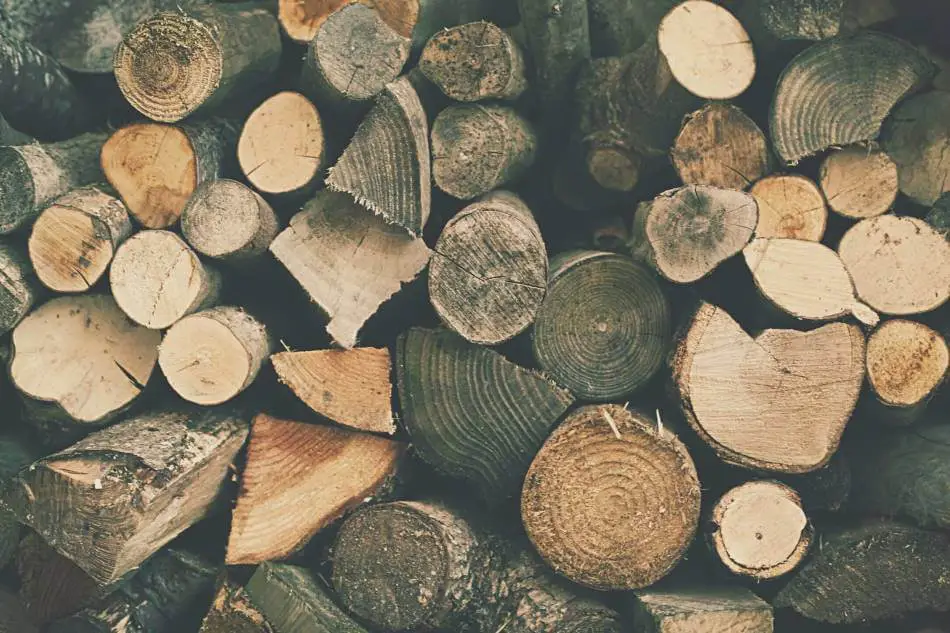
Exactly how long it will take depends on several factors, including the climate where you’re located (e.g. wood dries faster in Texas than in Oregon), and if you’ve properly split and stacked the wood.
In order to expedite the process, and to get your firewood seasoned as quickly as possible, use the following tips for fast drying:
5 Tips for Seasoning Firewood Fast
1. Split the firewood
firewood dries WAY faster when it is split into pieces, rather than sitting in log-form. Think about it, when the wood is split more surface area is exposed to the wind and sunshine, which are the primary contributors to dry wood.
2. Elevate the firewood
You may do a double take here, because a lot of people don’t do this step due to the extra effort required. And I’ll admit, this isn’t absolutely essential, but if you put your stack of firewood up on some pallets or perpendicular planks, it will increase airflow beneath the firewood stack and will accelerate your drying time.
3. Stack the firewood
To optimize your drying time, you should stack your firewood neatly in a location that will maximize the amount of sunshine and airflow. For example, stack the wood away from buildings (out of the shade), and point the face of the stack (not the ends) towards the direction from which you get the most breeze.
4. Leave space between rows
if you make multiple stacks of firewood, each stack should be separated by at least a few inches for airflow. This will allow both stacks of wood to dry better.
5. Cover (optional)
If your wood pile is outside you can put a cover or tarp over the stack to drain any rain/snow. Just make sure that it doesn’t totally block airflow from the side of the stack, otherwise it will trap in moisture and make seasoning take longer.
If you want to learn more about seasoning firewood, you should take a look at this article. And if you’re curious about whether you can stack and dry your firewood in your garage or shed, check out this article.
Related Questions
What is the Best Firewood?
The best type of firewood for heating a home with a wood stove, is Black Locust or Hickory, due to the high heat output and long-lasting coals. For outdoor campfires, Pine or Cedar are better because they produce a pleasant fire that doesn’t burn too long.
Is Elm a Hardwood?
Elm is a hardwood because it is a deciduous tree, meaning it loses its leaves every year. For a tree to be a hardwood is based on whether that tree is deciduous, not on the density of the wood. Softwood trees are conifers, like Pine, which are evergreen and have needles instead of leaves.